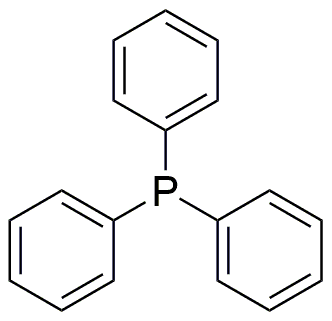Triphenylphosphine is widely utilized in research focused on:
- Synthesis of Organophosphorus Compounds: It serves as a key reagent in the synthesis of various organophosphorus compounds, which are important in agriculture and pharmaceuticals.
- Catalysis: This compound acts as a catalyst in numerous organic reactions, enhancing reaction rates and selectivity, particularly in the production of fine chemicals.
- Ligand in Coordination Chemistry: It is commonly used as a ligand in coordination complexes, which are essential in materials science and catalysis, providing stability and reactivity.
- Pharmaceutical Development: In medicinal chemistry, it plays a role in drug development, particularly in the synthesis of phosphine-based drugs that exhibit biological activity.
- Organic Photovoltaics: Triphenylphosphine is utilized in the development of organic solar cells, contributing to the advancement of renewable energy technologies.
General Information
Properties
Safety and Regulations
Applications
Triphenylphosphine is widely utilized in research focused on:
- Synthesis of Organophosphorus Compounds: It serves as a key reagent in the synthesis of various organophosphorus compounds, which are important in agriculture and pharmaceuticals.
- Catalysis: This compound acts as a catalyst in numerous organic reactions, enhancing reaction rates and selectivity, particularly in the production of fine chemicals.
- Ligand in Coordination Chemistry: It is commonly used as a ligand in coordination complexes, which are essential in materials science and catalysis, providing stability and reactivity.
- Pharmaceutical Development: In medicinal chemistry, it plays a role in drug development, particularly in the synthesis of phosphine-based drugs that exhibit biological activity.
- Organic Photovoltaics: Triphenylphosphine is utilized in the development of organic solar cells, contributing to the advancement of renewable energy technologies.
Documents
Safety Data Sheets (SDS)
The SDS provides comprehensive safety information on handling, storage, and disposal of the product.
Product Specification (PS)
The PS provides a comprehensive breakdown of the product’s properties, including chemical composition, physical state, purity, and storage requirements. It also details acceptable quality ranges and the product's intended applications.
Certificates of Analysis (COA)
Search for Certificates of Analysis (COA) by entering the products Lot Number. Lot and Batch Numbers can be found on a product’s label following the words ‘Lot’ or ‘Batch’.
*Catalog Number
*Lot Number
Certificates Of Origin (COO)
This COO confirms the country where the product was manufactured, and also details the materials and components used in it and whether it is derived from natural, synthetic, or other specific sources. This certificate may be required for customs, trade, and regulatory compliance.
*Catalog Number
*Lot Number
Safety Data Sheets (SDS)
The SDS provides comprehensive safety information on handling, storage, and disposal of the product.
DownloadProduct Specification (PS)
The PS provides a comprehensive breakdown of the product’s properties, including chemical composition, physical state, purity, and storage requirements. It also details acceptable quality ranges and the product's intended applications.
DownloadCertificates of Analysis (COA)
Search for Certificates of Analysis (COA) by entering the products Lot Number. Lot and Batch Numbers can be found on a product’s label following the words ‘Lot’ or ‘Batch’.
*Catalog Number
*Lot Number
Certificates Of Origin (COO)
This COO confirms the country where the product was manufactured, and also details the materials and components used in it and whether it is derived from natural, synthetic, or other specific sources. This certificate may be required for customs, trade, and regulatory compliance.


